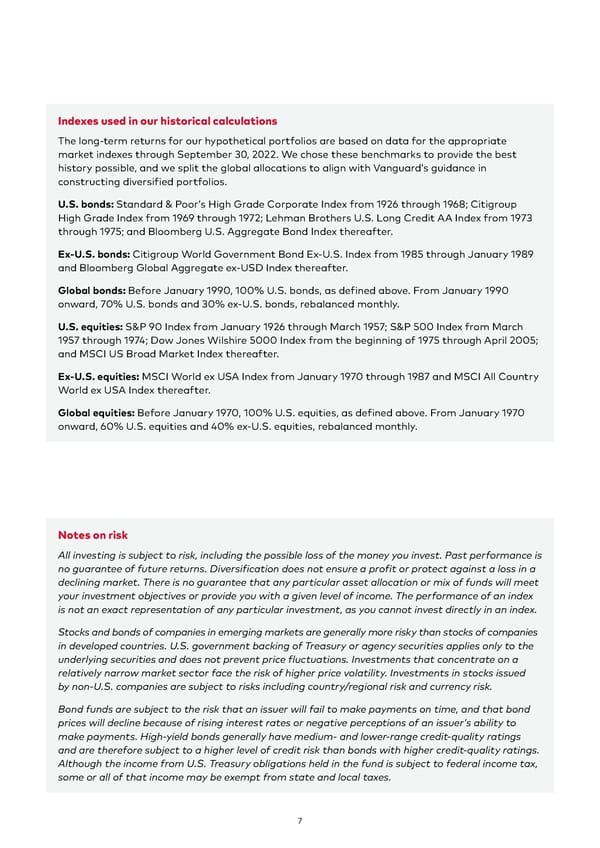Indexes used in our historical calculations The long-term returns for our hypothetical portfolios are based on data for the appropriate market indexes through September 30, 2022. We chose these benchmarks to provide the best history possible, and we split the global allocations to align with Vanguard’s guidance in constructing diversified portfolios. U.S. bonds: Standard & Poor’s High Grade Corporate Index from 1926 through 1968; Citigroup High Grade Index from 1969 through 1972; Lehman Brothers U.S. Long Credit AA Index from 1973 through 1975; and Bloomberg U.S. Aggregate Bond Index thereafter. Ex-U.S. bonds: Citigroup World Government Bond Ex-U.S. Index from 1985 through January 1989 and Bloomberg Global Aggregate ex-USD Index thereafter. Global bonds: Before January 1990, 100% U.S. bonds, as defined above. From January 1990 onward, 70% U.S. bonds and 30% ex-U.S. bonds, rebalanced monthly. U.S. equities: S&P 90 Index from January 1926 through March 1957; S&P 500 Index from March 1957 through 1974; Dow Jones Wilshire 5000 Index from the beginning of 1975 through April 2005; and MSCI US Broad Market Index thereafter. Ex-U.S. equities: MSCI World ex USA Index from January 1970 through 1987 and MSCI All Country World ex USA Index thereafter. Global equities: Before January 1970, 100% U.S. equities, as defined above. From January 1970 onward, 60% U.S. equities and 40% ex-U.S. equities, rebalanced monthly. Notes on risk All investing is subject to risk, including the possible loss of the money you invest. Past performance is no guarantee of future returns. Diversification does not ensure a profit or protect against a loss in a declining market. There is no guarantee that any particular asset allocation or mix of funds will meet your investment objectives or provide you with a given level of income. The performance of an index is not an exact representation of any particular investment, as you cannot invest directly in an index. Stocks and bonds of companies in emerging markets are generally more risky than stocks of companies in developed countries. U.S. government backing of Treasury or agency securities applies only to the underlying securities and does not prevent price fluctuations. Investments that concentrate on a relatively narrow market sector face the risk of higher price volatility. Investments in stocks issued by non-U.S. companies are subject to risks including country/regional risk and currency risk. Bond funds are subject to the risk that an issuer will fail to make payments on time, and that bond prices will decline because of rising interest rates or negative perceptions of an issuer’s ability to make payments. High-yield bonds generally have medium- and lower-range credit-quality ratings and are therefore subject to a higher level of credit risk than bonds with higher credit-quality ratings. Although the income from U.S. Treasury obligations held in the fund is subject to federal income tax, some or all of that income may be exempt from state and local taxes. 7
 Vanguard economic and market outlook for 2023 Page 6 Page 8
Vanguard economic and market outlook for 2023 Page 6 Page 8